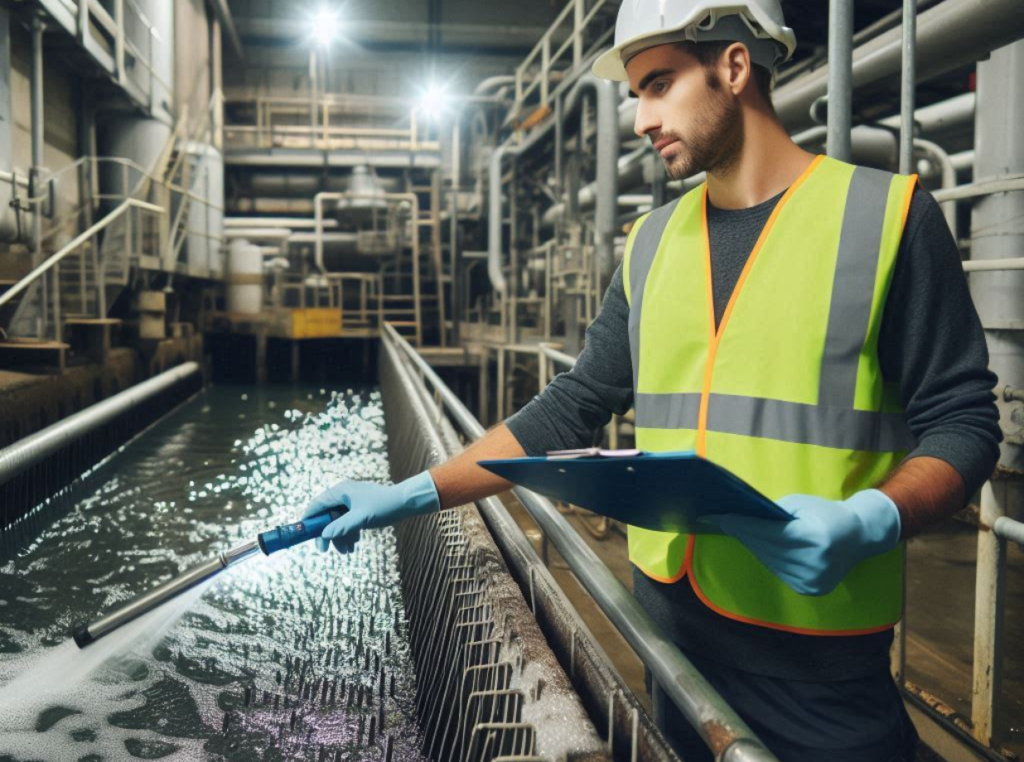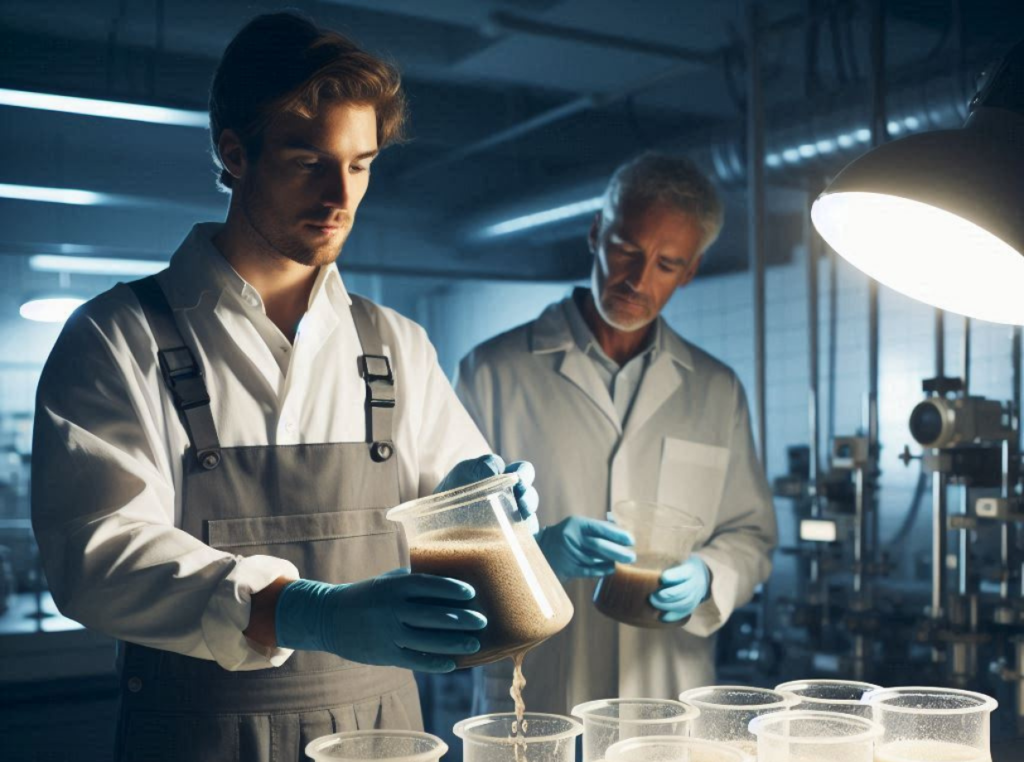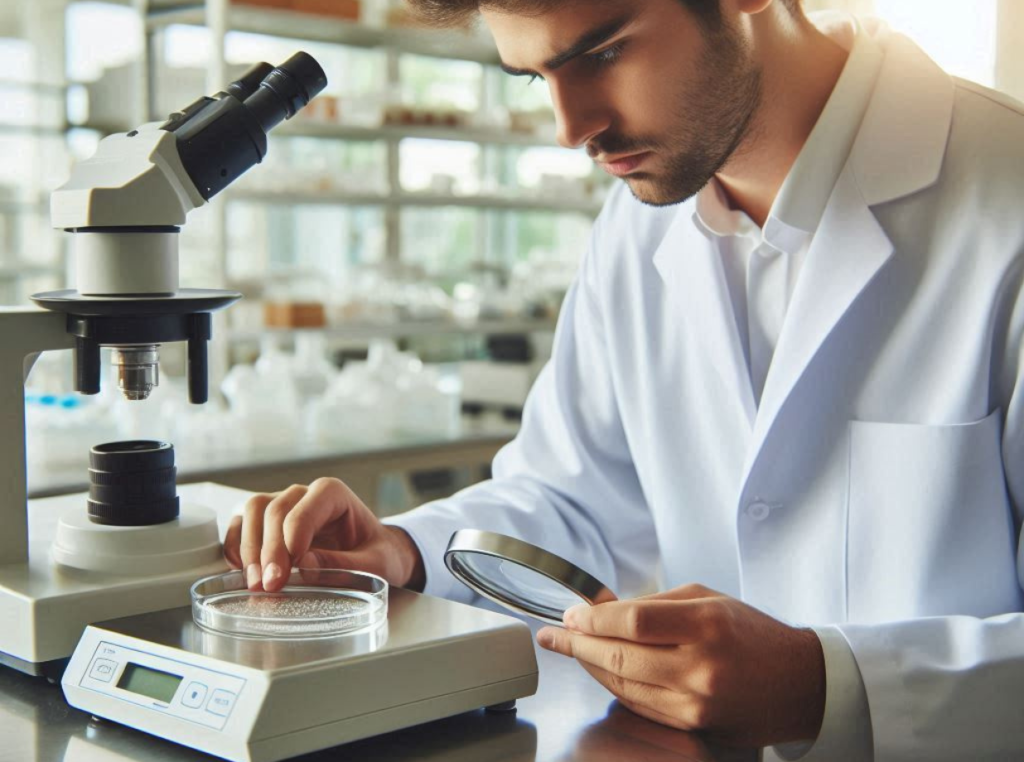In the fast-changing world of wastewater treatment, getting accurate data is key. Proper sampling and analysis of activated sludge are vital. This guide will cover the best ways to sample activated sludge. It aims to help you improve your water quality testing and environmental monitoring.

Key Takeaways
- Understand the basics of activated sludge and its role in wastewater treatment
- See why proper sampling is crucial for getting accurate data
- Know the essential tools needed for effective sampling
- Get step-by-step advice on the sampling process, from start to finish
- Learn how to keep and move activated sludge samples properly
- Find out how to analyze samples and understand the results
- Discover ways to fix common problems and adjust sampling frequency
Understanding Activated Sludge Sampling
At the heart of efficient wastewater treatment lies activated sludge, a key component in the biological treatment of water. Activated sludge is a complex mixture of microorganisms, primarily bacteria, that play a vital role in removing contaminants from wastewater. Proper sampling of this crucial element is essential to ensure the accuracy and reliability of water quality testing and monitoring.
What is Activated Sludge?
Activated sludge is a suspension of microorganisms that are cultivated and maintained in wastewater treatment plants. These microbes feed on organic matter and other contaminants, effectively breaking them down and purifying the water. The resulting activated sludge is then recycled back into the treatment process to continue the cycle of biological treatment.
Importance of Proper Sampling
Accurate sampling of activated sludge is crucial for monitoring the performance and efficiency of the wastewater treatment system. The microbial composition and settling characteristics of the sludge directly impact the treatment process, and any variations in these parameters can have significant consequences on the overall water quality. Proper sampling techniques ensure that the collected samples accurately reflect the current state of the activated sludge, allowing for informed decision-making and timely adjustments to the treatment process.
“The key to effective wastewater treatment lies in understanding and properly managing the activated sludge system, and that starts with accurate sampling.”
Essential Equipment for Activated Sludge Sampling
To get high-quality activated sludge samples, you need the right tools. This includes special containers and protective gear. Having the right setup is key for keeping samples safe and accurate. Let’s look at the must-haves for every wastewater analysis lab.
Sampling Containers
Choosing the right containers is the first step. Glass or plastic bottles with tight lids are best for activated sludge. They should be clean, free of contaminants, and big enough for the sample.
Sampling Poles and Devices
A sampling pole or device can reach hard spots in the treatment process. Tools like telescoping poles, dippers, and special cups are very helpful.
Personal Protective Equipment (PPE)
- Gloves: Latex or nitrile gloves protect your hands from contaminants.
- Goggles: Safety goggles protect your eyes from splashes.
- Coveralls: Disposable coveralls prevent cross-contamination.
- Boots: Steel-toed or rubber boots keep your feet safe in wet places.
Preservation Supplies
You might need extra stuff for keeping samples right, like ice packs, coolers, and preservative chemicals.
With this sampling equipment, you can make sure your wastewater analysis and lab supplies are top-notch. This leads to more trustworthy results.
“Proper sampling is the foundation of accurate wastewater analysis. Investing in the right tools and techniques can make all the difference.”
Activated Sludge Sampling: Step-by-Step Guide
Getting high-quality activated sludge samples is key for good field testing and analysis. It’s vital to stick to a standard sampling procedure for reliable results. Let’s look at how to prepare for and collect these samples step by step.
Preparing for Sampling
Before starting the sampling, there are a few important steps to take:
- Find the right sample spots based on your study or monitoring goals.
- Get all the needed tools, like clean containers, safety gear, and field testing kits.
- Check the standard methods and guidelines for activated sludge sampling to follow industry best practices.
- Know the site layout and any safety risks to plan a safe and efficient sampling trip.
Collecting the Sample
After getting ready, it’s time to collect the activated sludge sample. Follow these steps to get a good, clean sample:
- Put the sample container in the water at the right depth, with the opening facing the flow.
- Slowly lower the container and let it fill, without disturbing the sludge bed or stirring up sediment.
- Seal the container right away to keep the sample safe from loss or contamination.
- Mark the sample container with important details like location, date, time, and more.
By following these steps for sampling preparation and collection, you can make sure your activated sludge samples are good, reliable, and ready for analysis and testing.
“Proper sampling is the foundation for accurate analysis and informed decision-making in water treatment processes.”
Preserving and Transporting Activated Sludge Samples
Keeping activated sludge samples in good condition is key. This ensures they stay safe during storage and transport to labs. By following the right steps, you keep the sample’s chemical and biological makeup intact. This makes lab analysis more accurate and reliable.
Proper Sample Preservation
To keep activated sludge samples ready for lab tests, follow these tips:
- Use clean, sterile bottles or jars to collect samples to avoid contamination.
- Keep samples at 4°C (39°F) or below to maintain the cold chain.
- Don’t let samples get direct sunlight or extreme temperatures, as it can change their properties.
- Document the chain of custody, noting the date, time, and location of collection, and who collected it.
- Get the samples to the lab as fast as you can, usually within 24 hours, to prevent changes.
By sticking to these preservation tips, you help make lab results more accurate. This is vital for monitoring and improving the activated sludge treatment process.
| Preservation Technique | Holding Time | Container | Temperature |
|---|---|---|---|
| Refrigeration | 24-48 hours | Glass or plastic | 4°C (39°F) |
| Freezing | Up to 6 months | Glass or plastic | -20°C (-4°F) |
| Chemical preservation | Varies by parameter | Glass or plastic | 4°C (39°F) |

“Proper sample preservation and handling are critical for ensuring the accuracy and reliability of laboratory analysis results.”
Analyzing Activated Sludge Samples
Testing activated sludge samples is key to keeping wastewater treatment systems healthy. By analyzing these samples, experts learn a lot about the sludge’s physical, chemical, and biological makeup. This knowledge helps them improve treatment processes and follow rules.
Many standard tests are used to check the sludge’s different aspects. These include:
- Suspended solids – Shows how dense and how well the sludge settles.
- Dissolved oxygen – Tells us how much oxygen is there for microbes to work with. This is crucial for keeping the treatment process aerobic.
- Microbial populations – Looks at the types and amounts of bacteria and other microbes that clean the wastewater.
Quality control is very important in this testing process. It makes sure the results are right and reliable. This is done by using the right tools, following strict testing steps, and checking the results themselves.
| Parameter | Test Method | Importance |
|---|---|---|
| Suspended Solids | Gravimetric Analysis | Indicates sludge density and settling characteristics |
| Dissolved Oxygen | Electrochemical Measurement | Monitors aerobic conditions for microbial activity |
| Microbial Populations | Microscopic Examination | Evaluates diversity and abundance of treatment microbes |
Understanding the data from these tests is crucial. It helps experts make smart choices about how to run the activated sludge process. By watching these important factors, they can keep wastewater clean and meet environmental standards.
Interpreting Activated Sludge Sampling Results
Understanding the data from activated sludge sampling is key to knowing how well your wastewater treatment system works. By looking at important parameters, you can spot problems, make smart choices, and improve the treatment process.
Evaluating Key Parameters
When you look at the results of activated sludge sampling, pay attention to these main points:
- Mixed Liquor Suspended Solids (MLSS) – This shows how much solid material is in the aeration tank. It tells you how much biomass is ready to treat waste.
- Sludge Volume Index (SVI) – The SVI helps you see how well the sludge settles. It shows if the sedimentation process is working right.
- Dissolved Oxygen (DO) – Checking DO levels in the aeration tank makes sure microorganisms have enough oxygen. This helps them break down contaminants well.
- pH – Keeping the pH in the right range is crucial for the growth and activity of the activated sludge microorganisms.
By carefully looking at these key parameters, you can find issues like process optimization, troubleshooting problems, and checking regulatory compliance. This data-driven way of data analysis helps you make smart choices. It improves your wastewater treatment system’s performance.

“Consistent monitoring and analysis of activated sludge sampling results are essential for maintaining the health and efficiency of your wastewater treatment system.”
Activated Sludge Sampling: Troubleshooting Tips
Getting accurate activated sludge samples is key for good wastewater treatment. Even experts face challenges during sampling. Here, we’ll share tips to overcome these issues and keep your samples reliable.
Addressing Sample Representativeness
Ensuring your sample is a true reflection of the system is crucial. Issues like uneven sludge, poor mixing, or wrong sampling spots can distort the sample. To fix this, try these strategies:
- Pick sampling spots that truly represent the system
- Mix the sludge well before taking the sample
- Steer clear of sampling near the aeration basin’s inlet or outlet
Dealing with Interferences
Activated sludge can have substances that mess with accurate analysis. Things like suspended solids, foaming agents, or chemical additives can skew results. To tackle this:
- Pre-treat the sample to remove or lessen these substances
- Use analytical methods that can handle these interferences
- Get advice from lab experts on dealing with these issues
Troubleshooting Equipment Issues
Equipment problems can also affect your sampling quality. Regular checks, proper calibration, and careful handling are vital for accurate results. If you run into equipment issues, follow these steps:
| Issue | Troubleshooting Tip |
|---|---|
| Faulty sampling device | Check for damage, clean, and follow the manufacturer’s care instructions |
| Inaccurate temperature monitoring | Make sure the temperature sensor is calibrated right and replace if needed |
| Unreliable pH measurements | Recalibrate the pH meter and replace the electrode if it’s not working |
By tackling these common issues, you can improve your activated sludge sampling program. This ensures you get reliable data for solving problems and making informed decisions.
Activated Sludge Sampling Best Practices
High-quality activated sludge sampling is key for good wastewater treatment. To get reliable results, it’s important to follow best practices. Here are some guidelines to help improve your sampling program.
Rigorous Documentation
Keeping detailed records is essential. It helps with quality management and improvement. Use logbooks, chain-of-custody forms, and other documents to keep your data safe and accurate.
Safety First
Safety must always come first. Make sure your team wears the right protective gear. Follow all safety rules and local laws to keep everyone and the environment safe.
Quality Assurance and Control
Quality assurance and control are crucial. Use equipment calibration, duplicates, and certified materials to check your results. Keep track of these steps to meet industry standards.
Continuous Improvement
Always look for ways to improve. Check your processes, find what needs work, and fix it. Stay up-to-date with new sampling methods and best practices.
Following these best practices will make your activated sludge sampling better. This helps with effective wastewater treatment and process management.
| Best Practice | Description |
|---|---|
| Rigorous Documentation | Maintain comprehensive records of sample collection, preservation, and analysis to ensure traceability and quality management. |
| Safety First | Prioritize personnel and environmental safety by using appropriate personal protective equipment and adhering to all relevant regulations. |
| Quality Assurance and Control | Implement robust QA/QC measures, including equipment calibration, field and laboratory duplicates, and the use of certified reference materials. |
| Continuous Improvement | Regularly review and optimize sampling processes to align with the latest industry standards and best practices. |
Optimizing Activated Sludge Sampling Frequency
Finding the right sampling frequency for activated sludge is key. It helps with monitoring and following rules. It’s a challenge to get enough data without wasting resources. But, with the right approach, it’s possible to save money and meet standards.
How often to sample depends on the sludge’s stability. If it changes a lot, you need to check it more often. But, if it stays the same, you can sample less.
Rules also guide how often to sample. These rules can change, so it’s important to keep up. This way, you avoid any trouble with the law.
The resources you have also matter. You need people and tools to do the sampling. Planning well helps you get the right balance.
Thinking about these points helps you set a good sampling frequency. This way, you get the data you need for process monitoring and follow regulatory compliance without spending too much. This approach makes your process better, helps you make smart choices, and shows you care about the environment.
“Optimizing sampling frequency is a delicate balance between the need for data and the practical realities of resource constraints.”
Conclusion
In this guide, we’ve covered the basics of effective activated sludge sampling. We talked about why it’s important and how to do it right. You now know the key steps and tools needed for reliable wastewater treatment.
Our main points are clear: activated sludge is crucial for good treatment, and sampling must be consistent and accurate. Properly preserving and analyzing samples is also key. By following these tips, you can improve your system’s performance and catch any problems early.
Now, keep learning about this topic. Look for more resources and stay current with new developments. By focusing on excellence in activated sludge sampling, you’ll be ready for future challenges. This will help keep your wastewater treatment system running smoothly for years.
Frequently Asked Questions
What is activated sludge?
Activated sludge is a mix of microorganisms used in wastewater treatment. It breaks down organic matter and nutrients. This is key to the treatment process.
Why is proper sampling of activated sludge important?
Proper sampling is vital to check the health of the wastewater system. It helps improve the process and meet regulations.
What equipment is needed for activated sludge sampling?
You need containers, poles, protective gear, and preservation materials for sampling. The right tools ensure sample quality.
How do I properly collect an activated sludge sample?
First, choose the right spot for sampling. Then, follow safety rules and use standard methods. This way, you get a clean and representative sample.
How should I preserve and transport activated sludge samples?
Keep samples at the right temperature and document their journey. This keeps the sample quality during transport to the lab.
What analyses are commonly performed on activated sludge samples?
Samples are tested for solids, oxygen levels, and microbes. These tests check how well the treatment works.
How can I interpret the results from activated sludge sampling?
By analyzing the data, you can see how well the system is working. This helps improve the treatment process.
What are some common challenges in activated sludge sampling?
Challenges include getting representative samples and dealing with equipment problems. Using best practices helps solve these issues.
What are the key best practices for activated sludge sampling?
Key practices include keeping good records, following safety rules, and improving the sampling program. These steps ensure quality and efficiency.
How do I determine the optimal sampling frequency for activated sludge?
Consider the system’s stability, regulations, and resources when setting the sampling frequency. This balance ensures effective monitoring without overdoing it.
Related Resources
Here are some valuable online resources for further information on activated sludge sampling and wastewater treatment:
- Comprehensive guide on wastewater sampling techniques and procedures.
- Professional association that provides resources, training, and publications on water quality and wastewater treatment.
- Organization focused on water quality, treatment, and distribution, offering various resources and standards.
- Global network of water professionals providing resources and knowledge on water management and treatment.
- Authoritative resource for water and wastewater analysis methods.
- Non-profit organization that conducts research on water quality and treatment, offering numerous publications and resources.
- Searchable database of environmental monitoring methods, including those for wastewater analysis.
- Provides guidelines and resources on water quality and sanitation, including wastewater management.
Remember to consult these resources in conjunction with your local regulations and plant-specific procedures. Always verify that the information is up-to-date and applicable to your specific situation.
